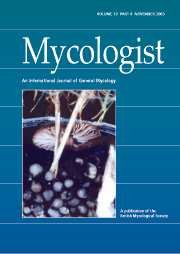Crossref Citations
This article has been cited by the following publications. This list is generated based on data provided by
Crossref.
2000.
21st Century Guidebook to Fungi.
p.
85.
Korkama, T.
Pakkanen, A.
and
Pennanen, T.
2006.
Ectomycorrhizal community structure varies among Norway spruce (Picea abies) clones.
New Phytologist,
Vol. 171,
Issue. 4,
p.
815.
Fomina, Marina
Burford, Euan P.
and
Gadd, Geoffrey M.
2006.
Fungi in Biogeochemical Cycles.
p.
236.
Allmér, Johan
Vasiliauskas, Rimvis
Ihrmark, Katarina
Stenlid, Jan
and
Dahlberg, Anders
2006.
Wood-inhabiting fungal communities in woody debris of Norway spruce (Picea abies (L.) Karst.), as reflected by sporocarps, mycelial isolations and T-RFLP identification.
FEMS Microbiology Ecology,
Vol. 55,
Issue. 1,
p.
57.
Ritz, Karl
2006.
Fungi in Biogeochemical Cycles.
p.
51.
Ritz, Karl
2007.
The Spatial Distribution of Microbes in the Environment.
p.
179.
Gadd, Geoffrey M.
Burford, Euan P.
Fomina, Marina
and
Melville, Karrie
2007.
Fungi in the Environment.
p.
77.
Deheyn, Dimitri D.
and
Latz, Michael I.
2007.
Bioluminescence characteristics of a tropical terrestrial fungus (Basidiomycetes).
Luminescence,
Vol. 22,
Issue. 5,
p.
462.
Gadd, Geoffrey M.
2007.
Geomycology: biogeochemical transformations of rocks, minerals, metals and radionuclides by fungi, bioweathering and bioremediation.
Mycological Research,
Vol. 111,
Issue. 1,
p.
3.
2008.
Stress in Yeast and Filamentous Fungi.
Vol. 27,
Issue. ,
p.
201.
Falconer, Ruth
Bown, James
Hart, Emma
and
Timmis, Jon
2008.
A New Paradigm for SpeckNets: Inspiration from Fungal Colonies.
p.
90.
2008.
Ecology of Saprotrophic Basidiomycetes.
Vol. 28,
Issue. ,
p.
183.
Falconer, Ruth E
Bown, James L
White, Nia A
and
Crawford, John W
2008.
Modelling interactions in fungi.
Journal of The Royal Society Interface,
Vol. 5,
Issue. 23,
p.
603.
Förster, Bernhard
Garcia, Marcos
Höfer, Hubert
Morgan, Edward
and
Römbke, Jörg
2009.
Tropical terrestrial model ecosystems for evaluation of soil fauna and leaf litter quality effects on litter consumption, soil microbial biomass and plant growth.
Pesquisa Agropecuária Brasileira,
Vol. 44,
Issue. 8,
p.
1063.
Allmér, Johan
Stenlid, Jan
and
Dahlberg, Anders
2009.
Logging-residue extraction does not reduce the diversity of litter-layer saprotrophic fungi in three Swedish coniferous stands after 25 years.
Canadian Journal of Forest Research,
Vol. 39,
Issue. 9,
p.
1737.
Ascough, Philippa L.
Sturrock, Craig J.
and
Bird, Michael I.
2010.
Investigation of growth responses in saprophytic fungi to charred biomass.
Isotopes in Environmental and Health Studies,
Vol. 46,
Issue. 1,
p.
64.
Lindahl, Björn D
de Boer, Wietse
and
Finlay, Roger D
2010.
Disruption of root carbon transport into forest humus stimulates fungal opportunists at the expense of mycorrhizal fungi.
The ISME Journal,
Vol. 4,
Issue. 7,
p.
872.
Boberg, Johanna B.
Finlay, Roger D.
Stenlid, Jan
and
Lindahl, Björn D.
2010.
Fungal C translocation restricts N‐mineralization in heterogeneous environments.
Functional Ecology,
Vol. 24,
Issue. 2,
p.
454.
Rottmann, Nils
Dyckmans, Jens
and
Joergensen, Rainer Georg
2010.
Microbial use and decomposition of maize leaf straw incubated in packed soil columns at different depths.
European Journal of Soil Biology,
Vol. 46,
Issue. 1,
p.
27.
Zareitalabad, Parva
Heinze, Stefanie
Rottmann, Nils
Potthoff, Martin
Dyckmans, Jens
and
Joergensen, Rainer Georg
2010.
Decomposition of 15N-labelled maize leaves in soil affected by endogeic geophagous Aporrectodea caliginosa.
Soil Biology and Biochemistry,
Vol. 42,
Issue. 2,
p.
276.

